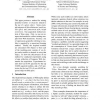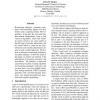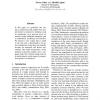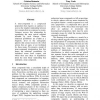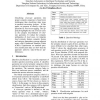COLING
2008
14 years 1 months ago
2008
This paper presents a method for mining potential troubles or obstacles related to the use of a given object. Some example instances of this relation are medicine, side effect and...
COLING
2008
14 years 1 months ago
2008
Recognizing analogies, synonyms, antonyms, and associations appear to be four distinct tasks, requiring distinct NLP algorithms. In the past, the four tasks have been treated inde...
COLING
2008
14 years 1 months ago
2008
In this paper we generalise the sentence compression task. Rather than simply shorten a sentence by deleting words or constituents, as in previous work, we rewrite it using additi...
COLING
2008
14 years 1 months ago
2008
In this paper, we consider classifying word positions by whether or not they can either start or end multi-word constituents. This provides a mechanism for "closing" cha...
COLING
2008
14 years 1 months ago
2008
We present an approach to ontology population based on a lexical substitution technique. It consists in estimating the plausibility of sentences where the named entity to be class...
COLING
2008
14 years 1 months ago
2008
A noun-compound is a compressed proposition that requires an audience to recover the implicit relationship between two concepts that are expressed as nouns. Listeners recover this...
COLING
2008
14 years 1 months ago
2008
We present an automatic method for senselabeling of text in an unsupervised manner. The method makes use of distributionally similar words to derive an automatically labeled train...
COLING
2008
14 years 1 months ago
2008
We study the self-organization of the consonant inventories through a complex network approach. We observe that the distribution of occurrence as well as cooccurrence of the conso...
COLING
2008
14 years 1 months ago
2008
Classifying what-type questions into proper semantic categories is found more challenging than classifying other types in question answering systems. In this paper, we propose to ...
COLING
2008
14 years 1 months ago
2008
Almost all automatic semantic role labeling (SRL) systems rely on a preliminary parsing step that derives a syntactic structure from the sentence being analyzed. This makes the ch...
